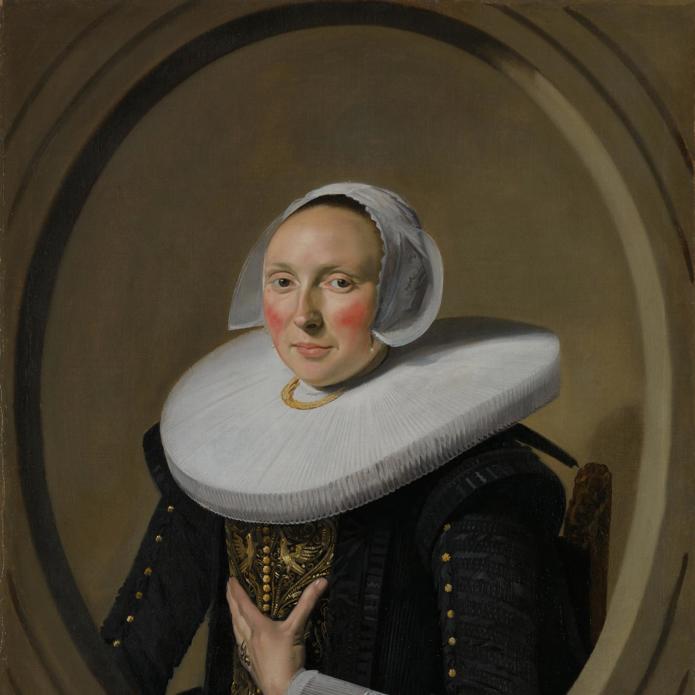Frans Hals, 'Portrait of Marie Larp', about 1635
About the work
Overview
An eighteenth-century label stuck on the back of this painting identifies the sitter as Marie Larp. It forms a pendant to the portrait of her husband, the Haarlem silk dyer Pieter Tjarck. The pair must have commissioned their portraits from Frans Hals soon after their wedding in 1634, when Hals was at the height of his career as Haarlem’s most eminent portrait painter.
Larp is shown seated in an upright position within a fictive oval frame, looking directly at the viewer. The stark black and white of her costume might suggest sober restraint, but closer examination reveals luxurious and costly details. Hals’s fluid brushwork records the varied textures of fine linen, thick gold embroidery and delicate lace, and imparts a pleasant, personable character to the sitter’s rosy-cheeked face.
Key facts
Details
- Full title
- Portrait of Marie Larp
- Artist
- Frans Hals
- Artist dates
- 1582/3 - 1666
- Part of the series
- Pendant portraits of Pieter Dircksz Tjarck and Marie Larp
- Date made
- about 1635
- Medium and support
- oil on canvas
- Dimensions
- 83.4 × 68.1 cm
- Acquisition credit
- Presented by the Misses Rachel F. and Jean I. Alexander; entered the Collection, 1972
- Inventory number
- NG6413
- Location
- Not on display
- Collection
- Main Collection
Provenance
Additional information
Text extracted from the ‘Provenance’ section of the catalogue entry in Neil MacLaren, revised and expanded by Christopher Brown, ‘National Gallery Catalogues: The Dutch School: 1600–1900’, London 1991; for further information, see the full catalogue entry.
Exhibition history
-
2023The Credit Suisse Exhibition: Frans HalsThe National Gallery (London)30 September 2023 - 21 January 2024
Bibliography
-
1973The National Gallery, The National Gallery: January 1971 - December 1972, London 1973
-
1991Maclaren, Neil, revised by Christopher Brown, National Gallery Catalogues: The Dutch School, 1600-1900, 2nd edn (revised and expanded), 2 vols, London 1991
-
2001
C. Baker and T. Henry, The National Gallery: Complete Illustrated Catalogue, London 2001
About this record
If you know more about this work or have spotted an error, please contact us. Please note that exhibition histories are listed from 2009 onwards. Bibliographies may not be complete; more comprehensive information is available in the National Gallery Library.
Images
About the series: Pendant portraits of Pieter Dircksz Tjarck and Marie Larp

Overview
These pendants depict the Haarlem couple Pieter Tjarck and Marie Larp. They likely commissioned Frans Hals to paint their portraits shortly after their wedding in 1634, when Hals was at the height of his career as the most eminent portrait painter in Haarlem.
Donning an impressive moustache, Tjarck wears a wide-brimmed hat and casually rests his elbow on the top of his chair while dangling a rose from his hand – a symbol of love for his wife. His relaxed pose contrasts sharply with Larp’s upright stance. Her hand gesture may reciprocate his affection, indicating that love resides in the heart, but it mostly draws attention to her faultless posture. Hals’s fluid brushwork records the varied textures of her fine linen, thick gold embroidery and delicate lace, imparting a pleasant, personable character to the sitter’s rosy-cheeked face.










